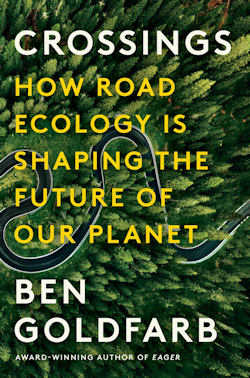SEJournal Online is the digital news magazine of the Society of Environmental Journalists. Learn more about SEJournal Online, including submission, subscription and advertising information.
 |
BookShelf: Roadkill Makes for Jolting Read in ‘Crossings’
“Crossings: How Road Ecology Is Shaping the Future of Our Planet”
By Ben Goldfarb
W.W. Norton & Co. $30.00
 |
Reviewed by Tom Henry
As I started reading Ben Goldfarb’s wonderful book, “Crossings: How Road Ecology Is Shaping the Future of Our Planet,” a thought popped into my head: “Cool topic, but how’s he going to get a whole book out of roadkill, urban sprawl and the national obsession with highways?”
Man, was I blown away.
First, I credit Goldfarb not only for going to all corners of the Earth to gather information about the nexus between humans, wildlife and roads, but I also credit him for the creativity of his research.
Blacktop and concrete, along with the automotive age itself, have obviously changed society. Highways, back roads, parking lots, driveways, roundabouts — you name it. All of that pavement is having an impact. And it’s not just by having so many impervious surfaces that allow runoff into local waterways, a major source of water pollution.
40 million miles of road
Goldfarb notes how there are now some 40 million miles of roadways encircling the planet. Yet people tend to view them as necessary infrastructure for humanity’s convenience and not much else.
To animals, though, vehicles are predators, and roadways are deadly obstacles.
There’s no going back, of course. But Goldfarb does a great job of showing what’s possible in cities such as Syracuse, New York, where an opportunity arose to stop promoting so much white flight to the suburbs by doing things a little differently. And he met with conservationists building bridges for mountain lions in California and tunnels for toads in England, among others.
Roadkill is explained not just in the obvious deer, squirrel and possum carcasses. Goldfarb shows how major victims include many reptiles, amphibians and overlooked members of the insect world that play important roles in the balance of nature.
Goldfarb notes that it ‘has
never been more dangerous
to set paw, hoof or scaly belly
on the highway’ as it is today.
Goldfarb notes that it “has never been more dangerous to set paw, hoof or scaly belly on the highway” as it is today.
But who among us would have known that the island of Tasmania, south of Australia, is the worst place in the world for roadkill?
Meanwhile, frogs and salamanders perish largely unnoticed all over the world. “You’ve probably never heard one pop beneath your tires, but in many places it’s herps — not deer, not squirrels — that make up most vertebrate roadkill,” he writes.
Lopping off migration routes
When I say that Goldfarb was creative with his research, I mean he explored countless angles other than lethal collisions.
There’s evidence that noise alone, for instance, has a huge impact on wildlife, such as migratory songbirds.
The Interstate Highway System also “lopped off migration routes as neatly as a guillotine,” he writes. In one part of the book, Goldfarb writes how roads have made migration “a dangerous bet.”
It’s long been known that monarch butterflies are struggling, in large part because of valuable milkweed that is destroyed along roadways.
“The collapse of migration transcends individual species,” he writes. “It is the endangerment of a biological process, the loss of a lifeway nearly as ancient as movement itself.”
Throughout the book, Goldfarb makes witty observations to help explain science in layman’s terms.
The tone of his writing
suggests some hope exists
in communities that are
trying to be innovative.
While his book is a real eye-opener, the tone of his writing suggests some hope exists in communities that are trying to be innovative in terms of road engineering, environmental planning and design, especially as Earth’s population grows and more vehicles are expected to be on the road.
The book provides countless examples and potential remedies for harm done by roads. It’s neither bleak nor overly optimistic.
It also addresses some of the racial undertones of roads. Goldfarb notes that air pollution disproportionately affects Blacks, Asian Americans and Latinos because many live in closer proximity to highways.
“Crossings” is Ben Goldfarb’s second book. It has received accolades from The New York Times, Smithsonian magazine, Kirkus Reviews, The New Yorker, Science News, Booklist, the New York Public Library and many others.
He also is author of “Eager: The Surprising, Secret Life of Beavers and Why They Matter,” which won the PEN/E.O. Wilson Literary Science Writing Award, and took third place for the Rachel Carson Environment Book Award in the Society of Environmental Journalists’ 18th Annual Awards for Reporting on the Environment.
Tom Henry is SEJournal’s BookShelf editor and a former SEJ board member.
* From the weekly news magazine SEJournal Online, Vol. 9, No. 17. Content from each new issue of SEJournal Online is available to the public via the SEJournal Online main page. Subscribe to the e-newsletter here. And see past issues of the SEJournal archived here.













 Advertisement
Advertisement 



